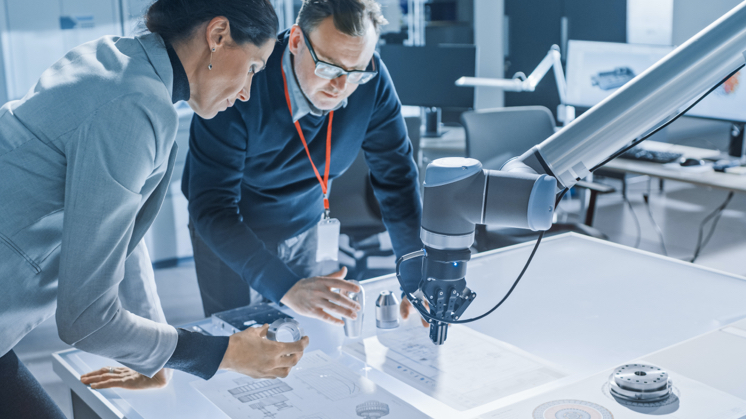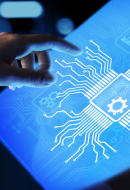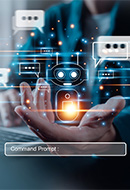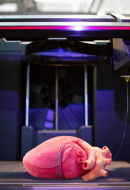Hyperautomation meaning
What is hyperautomation and why is it essential for the digital transformation?
According to the consultancy Gartner, hyperautomation will be one of the technological trends that will have the greatest impact in the next decade. This concept, which goes far beyond mechanising repetitive manual tasks carried out by people, refers to the automation of any business process using a combination of robotic process automation (RPA) and other advanced technologies, such as Artificial Intelligence and Machine Learning.

At school, we learned that the First Industrial Revolution at the end of the 18th century used steam engines to automate the textile industry. A century later, the Second added electricity and the internal combustion engine, and at the end of the 20th century, the Third came along, with digitalisation and process automation.
We have not had long to wait for the Fourth Industrial Revolution, which brings robotisation, the Internet of Things and Artificial Inteligence. A process that is pushing the advanced countries towards reindustrialisation in order to recover their ability to produce their own consumer goods in a sustainable manner. In this new context, hyperautomation, also called digital process automation (DPA) or intelligent process automation (IPA), looks like being one of the technological trends that will have the greatest impact in the coming years.
What is hyperautomation
Hyperautomation consists of increasing the automation of business processes (production chains, work flows, marketing processes, etc.) by introducing Artificial Intelligence (AI), Machine Learning (ML) and Robotic Process Automation (RPA). To a point where almost any repetitive task can be automated and it is even possible to find out which processes can be automated and to create bots to perform them.
In addition, hyperautomation is a key factor in the digital transformation as it eliminates human involvement in low-value processes and provides data that offers a level of business intelligence that was not available before. It can become a key factor in building fluid organisations capable of adapting rapidly to change.
SEE INFOGRAPHIC: The road to hyperautomation [PDF] External link, opens in new window.
The key points of hyperautomation
Hyperautomation is not based on one single technology but on integrating a number of them, including:
Robotic Process Automation
Robotic process automation makes it possible to configure software that allows robots to perform repetitive, structured tasks in digital systems.
Machine Learning
Machine Learning is the technology that uses algorithms to teach computers to perform complex tasks by themselves without the need for additional programming by human beings.
Artificial Intelligence
The purpose of Artificial Intelligence is to create machines that are capable of making decisions and solving problems by emulating human logical thinking.
Big Data
Big Data is a set of technologies that make it possible to store, analyse and manage huge amounts of data produced by devices in order to identify patterns and create optimal solutions.
Cobots
Cobots are the prime example of collaborative robotics, in other words, robots that share tasks with human workers and are revolutionising production processes.
Chatbots
Chatbots are systems based on AI, ML and Natural Language Processing (NLP) that can hold a conversation in real time with a human being using text or speech.
How does hyperautomation work
According to Gartner, RPA enriched by AI and ML becomes the core that makes hyperautomation technology possible. By combining these technologies, power and flexibility can be added in places where they were not possible previously. So, tasks that previously could not be automated now can be, so that human capabilities can be focused on tasks with a greater value, such as decision making, interpreting data and using critical thinking.
"Hyperautomation involves combining a variety of tools, such as robotic process automation (RPS) and artificial intelligence (AI), in order to improve business decisions"
Gartner, ITC consultancy
Hyperautomation platforms are varied and can be implemented on top of the technologies that companies already have. The main platform, as has been said, is RPA, but there are also intelligent business process management suites (iBPMS), integration platforms as a service (iPaaS) and information engines. Hyperautomation can also help to create a digital twin of an organisation (DTO, Digital Twin Organisation), which is a virtual representation of a product or work flow that can simulate how processes interact and show where value is created in real time.
Advantages of hyperautomation
Hyperautomation has numerous advantages, both for the performance of a company as well as for the well-being of its workers. These include:
Trends in a hyper-automated world
Hyper-automation is becoming the new normal for businesses. More and more organisations have been implementing these systems to cut costs and streamline work. But how can we expect hyper-automation to evolve? Here are some examples of what’s in store for the near future:
- Hyper-personalised automation. Until now, these kinds of processes were largely generic. However, more and more ways are being developed to make them business-specific solutions, resulting in hyper-personalised automation. Thanks to ongoing advances in AI and data analytics, it will be easier for each organisation to create its own workflows tailored to their individual needs
- Generative artificial intelligence. One of the most significant changes will be that bots will not only perform tasks automatically but will also be able to adapt and learn from the work environment. This will be made possible by integrating robotic process automation (RPA) with generative artificial intelligence systems. In work environments such as factories, cafés and even restaurants, where these technologies are being incorporated to replace tasks such as waiters, we will see a substantial advance in real-time decision-making and work analysis.
- Sustainability. Sustainability, an area that is becoming increasingly important in daily business, will also benefit from hyper-automation. The use of RPA technology will reduce waste, polluting emissions and waste, which will be key for companies to achieve their sustainability goals.

What is a digital twin
It is not science fiction, they are digital twins, a disruptive technology that will be vital in the rise and progression of the Fourth Industrial Revolution.

What is Artificial Intelligence?
Its applications in multiple sectors have prompted the European Union to develop its own Robotics Laws.

What is big data and what is it used for?
Big data analyses a "sea of data" to convert it into the information that is transforming our world.

What is 4D printing and how does it work?
Intelligent designs that adapt to the environment and transform over time.
















